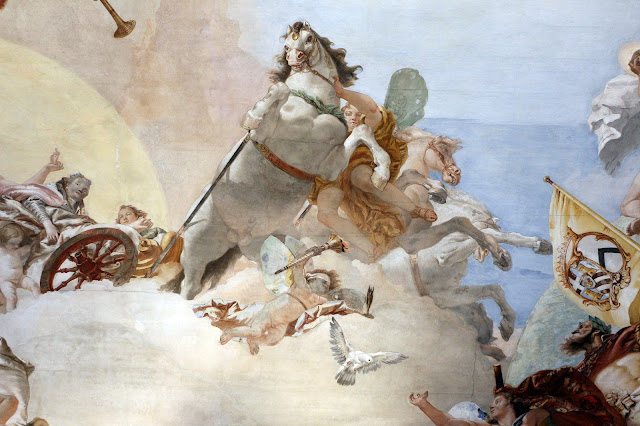 |
| Giambattista Tiepolo Glory of St Dominic (top) Institution of the Rosary (middle) Prayer of St Dominic (bottom) 1737-39 ceiling frescoes Chiesa dei Gesuati, Venice |
 |
| Giambattista Tiepolo Glory of St Dominic 1737-39 ceiling fresco Chiesa dei Gesuati, Venice |
 |
| Giambattista Tiepolo Institution of the Rosary 1737-39 ceiling fresco Chiesa dei Gesuati, Venice |
 |
| Giambattista Tiepolo Institution of the Rosary (detail) 1737-39 ceiling fresco Chiesa dei Gesuati, Venice |
 |
| Giambattista Tiepolo Institution of the Rosary (detail) 1737-39 ceiling fresco Chiesa dei Gesuati, Venice |
 |
| Giambattista Tiepolo Institution of the Rosary (detail) 1737-39 ceiling fresco Chiesa dei Gesuati, Venice |
 |
| Giambattista Tiepolo Institution of the Rosary (detail) 1737-39 ceiling fresco Chiesa dei Gesuati, Venice |
 |
| Giambattista Tiepolo Prayer of St Dominic 1737-39 ceiling fresco Chiesa dei Gesuati, Venice |
 |
| Giambattista Tiepolo Nuptial Allegory of Ludovico Rezzonico and Faustina Savorgnan 1757-58 ceiling fresco Ca' Rezzonico, Venice |
 |
| Giambattista Tiepolo Nuptial Allegory of Ludovico Rezzonico and Faustina Savorgnan (detail) 1757-58 ceiling fresco Ca' Rezzonico, Venice |
 |
| Giambattista Tiepolo Nuptial Allegory of Ludovico Rezzonico and Faustina Savorgnan (detail) 1757-58 ceiling fresco Ca' Rezzonico, Venice |
 |
| Giambattista Tiepolo Nuptial Allegory of Ludovico Rezzonico and Faustina Savorgnan (detail) 1757-58 ceiling fresco Ca' Rezzonico, Venice |
 |
| Giambattista Tiepolo Madonna of Carmel presenting the Scapular to St Simon Stock (detail) 1749 oil on canvas, installed as ceiling painting Scuola Grande dei Carmini, Venice |
 |
| Giambattista Tiepolo Madonna of Carmel presenting the Scapular to St Simon Stock (detail) 1749 oil on canvas, installed as ceiling painting Scuola Grande dei Carmini, Venice |
 |
| Giambattista Tiepolo Madonna of Carmel presenting the Scapular to St Simon Stock (detail) 1749 oil on canvas, installed as ceiling painting Scuola Grande dei Carmini, Venice |
"Tiepolo is not a difficult painter. He is accessible and easy to like. His fiery spirit, speed, boldness, inventiveness and the bizarreness of his thought were celebrated during his lifetime, the demand for his works was great, and other artists were said to have been jealous. He painted metre upon metre, including the largest and one of the greatest paintings in Europe [Apollo and the Four Continents, a ceiling fresco in the Residenz at Würzburg]. There he is again, one feels, though the personality in question is curiously absent and the hand is often that of his sons or others."
"But it is remarkable how little after-life his art has had. After the local interest taken in his paintings by artists in the German lands, he was by and large rejected or, worse, simply ignored and forgotten after his death. Many a painter has been celebrated in his day only to disappear from view. But it is surprising that one both so celebrated and so good does not have a more defined place within the canon of European painting or in the writing about it. His role, when he is seen to have one, is simply that of marking a tradition's end."
"To say that Tiepolo was forgotten because of a change in taste has the effect of placing him in a certain light – painter to a dying class, coming at the end of a tradition in art, a bit decadent. The conclusion has been drawn that he was out of touch with realities of both life and art. Today, praise of Tiepolo tends to be tinged with an apology along such lines: disempowered patrons – nouveaux riches Venetians, a provincial German prince-bishop, the Spanish king – took refuge in a fabulous dream-world, the dream-world, so it is implied, of Tiepolo's art. . . . But the style, public at every stage, is the man; and in Tiepolo's case it was to an extraordinary degree through his style that he was able to see, to think, to perform. It was not a disguise he hid behind, and it was never outgrown."
"Tiepolo satisfies neither a taste for what is loosely but confidently referred to as pictorial unity, nor a taste for narration, at least not in the sense of the dramatic enactment of events offered by many paintings in the European tradition. Restoring the truncated Tiepolo is partly an exercise in getting free of tastes such as these. He was a late-comer to the tradition of painting . . . and an early-comer to the definition of and interest in the aesthetic faculty. He offers an example of pictorial creativity from premisses that are not literary."
– from Tiepolo and the Pictorial Intelligence, Svetlana Alpers and Michael Baxandall (Yale University Press, 1994)